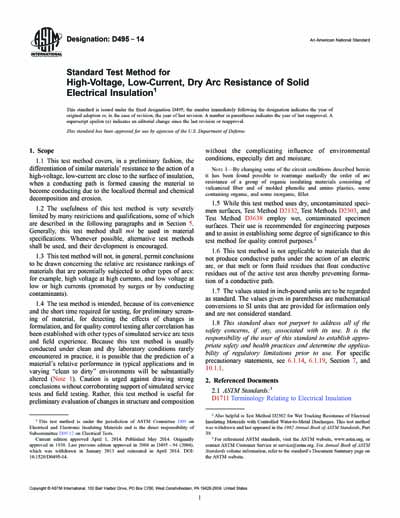Historical
ASTM D495-14
Standard Test Method for High-Voltage, Low-Current, Dry Arc Resistance of Solid Electrical Insulation
1.1 This test method covers, in a preliminary fashion, the differentiation of similar materials’ resistance to the action of a high-voltage, low-current arc close to the surface of insulation, when a conducting path is formed causing the material to become conducting due to the localized thermal and chemical decomposition and erosion.
1.2 The usefulness of this test method is very severely limited by many restrictions and qualifications, some of which are described in the following paragraphs and in Section 5. Generally, this test method shall not be used in material specifications. Whenever possible, alternative test methods shall be used, and their development is encouraged.
1.3 This test method will not, in general, permit conclusions to be drawn concerning the relative arc resistance rankings of materials that are potentially subjected to other types of arcs: for example, high voltage at high currents, and low voltage at low or high currents (promoted by surges or by conducting contaminants).
1.4 The test method is intended, because of its convenience and the short time required for testing, for preliminary screening of material, for detecting the effects of changes in formulation, and for quality control testing after correlation has been established with other types of simulated service arc tests and field experience. Because this test method is usually conducted under clean and dry laboratory conditions rarely encountered in practice, it is possible that the prediction of a material's relative performance in typical applications and in varying “clean to dirty” environments will be substantially altered (Note 1). Caution is urged against drawing strong conclusions without corroborating support of simulated service tests and field testing. Rather, this test method is useful for preliminary evaluation of changes in structure and composition without the complicating influence of environmental conditions, especially dirt and moisture.
1.5 While this test method uses dry, uncontaminated specimen surfaces, Test Method D2132, Test Methods D2303, and Test Method D3638 employ wet, contaminated specimen surfaces. Their use is recommended for engineering purposes and to assist in establishing some degree of significance to this test method for quality control purposes.2
ASTM International [astm]

